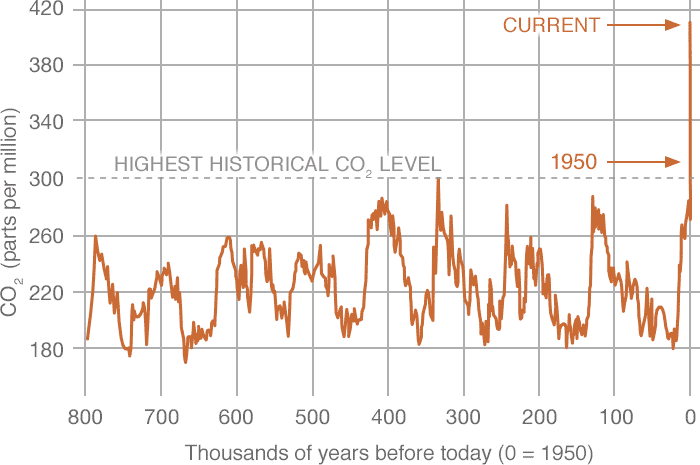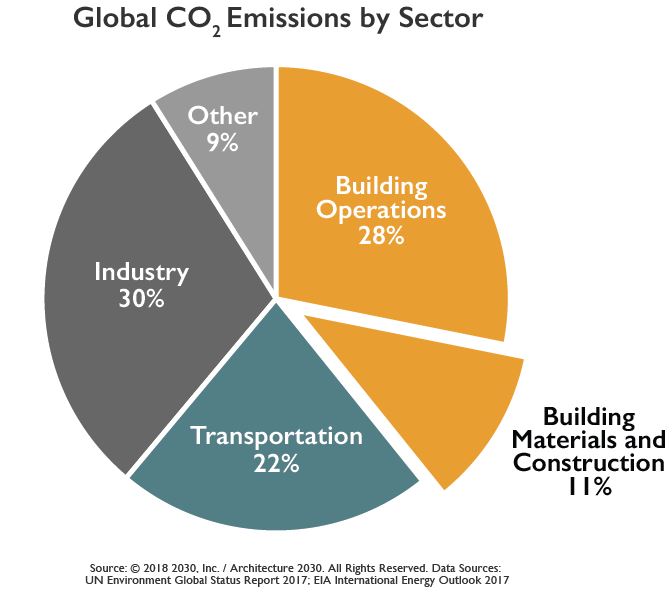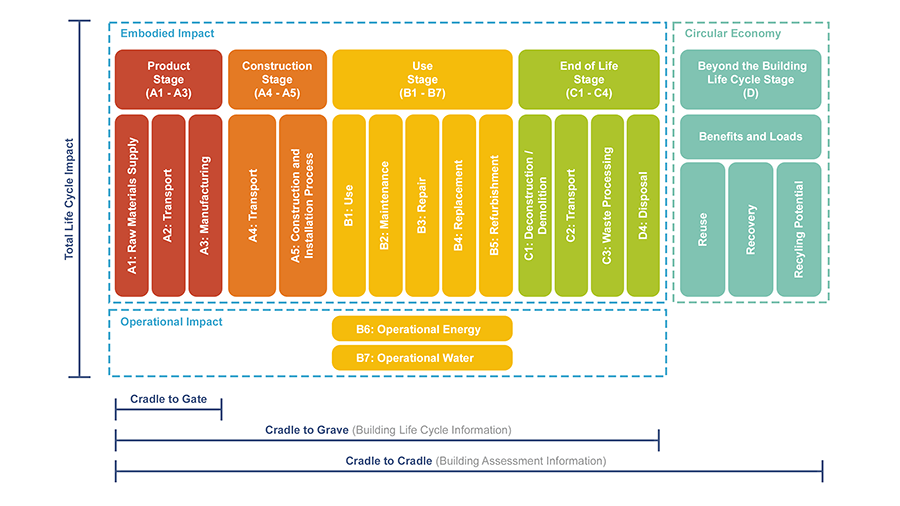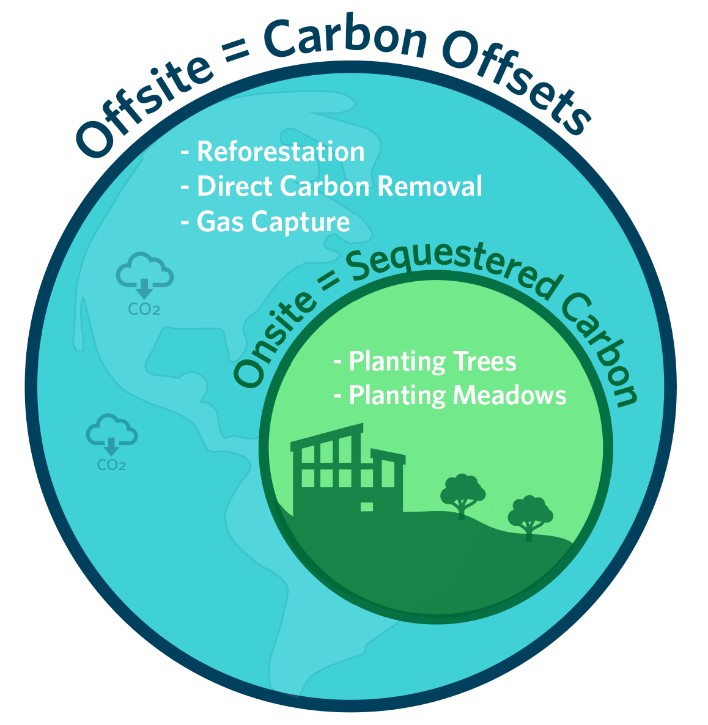‘Carbon’ is the new sustainability metric. At Bala, we see the building industry transitioning from measuring a building’s “sustainability” based on its energy efficiency and energy use to a more comprehensive model that includes both the operational and embodied carbon from the building. With this critical shift, it’s important we understand the fundamental relationship between carbon and climate change and the frameworks of carbon measurement, as it relates to the built environment.
Carbon Imbalance and Climate Change
Often when the term ‘carbon’ is used, it is a general term for greenhouse gas (GHG) emissions derived from the use of fossil fuels. We will refer to ‘carbon’ in this manner throughout this blog.
In the last century, there has been an unbalanced increase in the carbon in our system, that correlates with increased fossil fuel usage by human society. Shown in the graph below, carbon within the atmosphere has been relatively balanced for the last 800,000 years. Yet recently, since the 1950s, there’s been an unordinary and dramatic spike in carbon.

Image Source: https://climate.nasa.gov/vital-signs/carbon-dioxide/
This dramatic rise of carbon levels is alarming because the heat it traps within our atmosphere has directly led to climate change. With climate change’s drastic effects (including temperature rise, loss of biodiversity, sea level rise, food shortages, and much more) we face a grand challenge as a society to bring the carbon cycle back into sustainable operating parameters.
The Building Sector's Impact
The building sector produces 39% of the total greenhouse gas emissions over the course of a year globally. As highlighted in the pie chart, 28% of total global emissions come from the operation of our buildings and 11% comes from the materials we use to build our buildings and from the construction process.

Image Source: https://newbuildings.org/embodied-carbon-conundrum-solving-for-all-emission-sources-from-the-built-environment/
This means that the built environment has an immense impact on our future and the extent of the effects of climate change - but this also means that as practitioners in the field, we can have an equally large influence in reducing this impact and protecting our future.
So, as built environment professionals, what can we do to reduce our emissions and lessen the impacts of climate change? The best place to start is to measure. As they say, “you can’t manage what you don’t measure” meaning carbon accounting practices are the best place to begin.
Two Primary Carbon Accounting Frameworks
There are two major carbon accounting frameworks– the Greenhouse Gas Protocol and Whole Building Life Cycle Assessment (WBLCA). The Greenhouse Gas Protocol aligns with the ESG reporting methods, which many companies, outside of the building industry, are familiar with, while the WBLCA tool is specific to the built environment and is growing in popularity across the industry.
Greenhouse Gas Protocol
The Greenhouse Gas Protocol includes 3 scopes of emissions for corporations to track. Scope 1 are direct onsite emissions primarily stemming from natural gas use, company vehicle use, and fugitive emissions from refrigerants and other gases. Scope 2 emissions are those that are indirect and come from other entities providing electricity, steam, etc. Scope 3 emissions are indirect emissions from a company’s entire value chain – including upstream and downstream activities. This includes but is not limited to product manufacturing, business travel, employee commuting, waste, and more. These emissions categories are shown again in the graphic below.

At Bala, we’ve adopted this framework for our own carbon reporting. We’ve collected data from each of our offices, from scope 1 and 2 emissions such as energy use to scope 3 such as employee commuting, business travel, office waste creation and more. We will share our results and action plan for reducing our carbon emissions in an upcoming blog.
The Greenhouse Gas Protocol is a widely used framework for companies with a portfolio of buildings, especially given the shift towards carbon as a primary sustainability metric. Companies are being asked by their stakeholders and even now by the SEC (Securities and Exchange Commission) to be transparent and consistent with carbon emission reporting. Following the Greenhouse Gas Protocol established framework provides this consistency and transparency that is increasingly being expected from companies. Read more about the SEC sustainability reporting requirement here: https://www.sec.gov/news/statement/gensler-climate-disclosure-20220321.
Building design has immediate and direct influence over scope 1 and 2 emissions through the design of efficient systems and fuel choices. Therefore, building design and operation strongly impact companies’ ESG reporting when using the Greenhouse Gas Protocol and the building design community plays a significant role.
For example, building practitioners can influence building occupants by providing electric vehicle charging, which eliminates emissions from scope 1 and 3. We also have a direct influence over refrigerants, through HVAC system choices. Refrigerants fall under scope 1 – which Project Drawdown considers to be the number one method for reducing carbon in the atmosphere. There are of course other ways in which companies can reduce carbon emissions, however much of the work can come from our built spaces through effective choices, strategies and solutions from the design community.
Whole Building Life Cycle Assessment
The second primary framework for carbon accounting, specific to the building industry, is the Whole Building Life Cycle Assessment (WBLCA). This framework is broken out into stages of a building’s life starting from raw material extraction through manufacturing of products, construction, occupancy, all the way to the demolition and disposal of the building’s materials. The stages defined in the framework are shown in the graphic below. This framework focuses on singular buildings and is best utilized for new construction projects. Considering the full life of a building is critical for net zero design and leads to better project and carbon outcomes.

Image Source: https://browningday.com/news/lca-stages-matter-when-tracking-embodied-carbon/
As seen in the above visual, operational carbon – the carbon emitted from running the building during occupancy – is only a small portion of the whole conversation. Reducing operational carbon via energy efficient design has been the focus of the building industry for years. It has often been thought of as a solely HVAC issue with MEP firms taking the lead in energy reduction strategies. However, as we start to view our built spaces more like the mini ecosystems that they are, we start to see that all aspects of a design influence and modify other parts of the design.
Energy efficiency, as with carbon, starts at the building’s conception with the site planning, orientation, and design of the façade and envelope and is continued with proper construction and commissioning. These design aspects directly influence the engineered internal systems which use the energy and produce the carbon we are trying to mitigate. It is best to start this analysis early to increase the options for mitigation. We use some of the latest technologies for calculation and are developing our own calculators as well (more on that in future blogs). All design team members are influential in reducing carbon on a project.
Also pictured in the diagram above - Embodied carbon, is the carbon emitted from the full life of the materials used in a building–starting at extraction and extending all the way through disposal. With such a vast lifecycle, material selection and management require collaboration and communication from parties during each stage of this cycle to best reduce carbon output. Architects, owners, engineers, contractors, manufacturers, and more all have their part to play in this process. In the current market, tracking embodied carbon data for products or materials is not yet standardized. However, as more parties in the industry look for embodied carbon data, more will be produced, allowing for more accurate measurement and eventual reduction.
Additional Carbon to Consider
The final type of carbon to consider, in both the Greenhouse Gas Protocol and Whole Building Life Cycle Assessment frameworks, is carbon that can be sequestered or removed from the atmosphere either onsite or in a different location. This type of carbon can aid in reaching a net zero carbon status, since it is a direct subtraction of carbon from the total carbon of the project.
If the sequestered or removed carbon comes from onsite, it is referred to as “sequestered carbon”. If the carbon is coming from an off-site, different location, it is generally labelled a “carbon offset”. Onsite, sequestered carbon often comes from the planting of trees or other plants. This is more feasible and common with sites that have a large footprint or are part of a larger campus. Offsets, on the other hand, are broader in nature and include both the removal of carbon and the avoidance of emissions. Common offset types include reforestation, gas capture, and direct carbon removal.

Sequestered carbon and offsets are best utilized in concert with reductions in both operational and embodied carbon. Altogether, each form of carbon can be measured and optimized to reduce the built environment’s carbon footprint.
The Power of Measurement
Now that we know what to measure and the frameworks for doing so, we simply need to get started. Bala has completed a scope 1, 2, and 3 emissions inventory of our own operations, which allows us to effectively and strategically create an action plan to reduce the carbon intensity of our operations over time. Our clients are also increasingly asking us to measure carbon for their building designs following the Whole Building Life Cycle Assessment Approach. With a keen understanding of carbon as the new sustainability metric, Bala informs our clients by calculating carbon scopes and provides recommendations to reduce and mitigate emissions.
Even in the absence of “perfect” data, we need to start measuring what we can and ask for the information that we don’t yet have. When we get a handle on measurement, we can more effectively start to reduce emissions.

